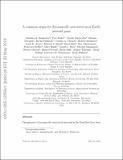| dc.contributor.author | Binzel, Richard P | |
| dc.contributor.author | DeMeo, Francesca E | |
| dc.contributor.author | Person, Michael J | |
| dc.date.accessioned | 2020-04-06T19:41:57Z | |
| dc.date.available | 2020-04-06T19:41:57Z | |
| dc.date.issued | 2019-11 | |
| dc.date.submitted | 2019-05 | |
| dc.identifier.issn | 1054-1381 | |
| dc.identifier.uri | https://hdl.handle.net/1721.1/124497 | |
| dc.description.abstract | Though pairs of dynamically associated asteroids in the Main Belt have been identified and studied for over a decade, very few pair systems have been identified in the near-Earth asteroid population. We present data and analysis that supports the existence of two genetically related pairs in near-Earth space. The members of the individual systems, 2015 EE7-2015 FP124 and 2017 SN16-2018 RY7, are found to be of the same spectral taxonomic class, and both pairs are interpreted to have volatile-poor compositions. In conjunction with dynamical arguments, this suggests that these two systems formed via YORP spin-up and/or dissociation of a binary precursor. Backwards orbital integrations suggest a separation age of <10 kyr for the pair 2017 SN16-2018 RY7, making these objects amongst the youngest multiple asteroid systems known to date. A unique separation age was not realized for 2015 EE7-2015 FP124 due to large uncertainties associated with these objects' orbits. Determining the ages of such young pairs is of great value for testing models of space weathering and asteroid spin-state evolution. As the NEO catalog continues to grow with current and future discovery surveys, it is expected that more NEO pairs will be found, thus providing an ideal laboratory for studying time dependent evolutionary processes that are relevant to asteroids throughout the Solar System. ©2019 | en_US |
| dc.description.sponsorship | NASA (Grant no. NNX14AN82G) | en_US |
| dc.description.sponsorship | NASA (Grant no. NNX17AH06G) | en_US |
| dc.description.sponsorship | NASA (Grant no. 80NSSC18K0849) | en_US |
| dc.language.iso | en | |
| dc.publisher | Elsevier BV | en_US |
| dc.relation.isversionof | 10.1016/J.ICARUS.2019.05.030 | en_US |
| dc.rights | Creative Commons Attribution-NonCommercial-NoDerivs License | en_US |
| dc.rights.uri | http://creativecommons.org/licenses/by-nc-nd/4.0/ | en_US |
| dc.source | arXiv | en_US |
| dc.title | A common origin for dynamically associated near-Earth asteroid pairs | en_US |
| dc.type | Article | en_US |
| dc.identifier.citation | Moskovitz, Nicholas A., et al., "A common origin for dynamically associated near-Earth asteroid pairs." Icarus 333 (2019): p. 165-76 doi 10.1016/J.ICARUS.2019.05.030 ©2019 Author(s) | en_US |
| dc.contributor.department | Massachusetts Institute of Technology. Department of Earth, Atmospheric, and Planetary Sciences | en_US |
| dc.relation.journal | Icarus | en_US |
| dc.eprint.version | Author's final manuscript | en_US |
| dc.type.uri | http://purl.org/eprint/type/JournalArticle | en_US |
| eprint.status | http://purl.org/eprint/status/PeerReviewed | en_US |
| dc.date.updated | 2020-04-03T16:58:11Z | |
| dspace.orderedauthors | Nicholas A. Moskovitz; Petr Fatka ; Davide Farnocchia; Maxim Devogele; David Polishook; Cristina A. Thomas; Michael Mommert; Louis D. Avner; Richard P. Binzel; Brian Burt; Eric Christensen; Francesca DeMeo; Mary Hinkle; Joseph L. Hora; Mitchell Magnusson; Robert Matson; Michael Person; Brian Skiff; Audrey Thirouin; David Trilling; Lawrence H. Wasserman; Mark Willman | en_US |
| dspace.date.submission | 2020-04-03T16:58:15Z | |
| mit.journal.volume | 333 | en_US |
| mit.license | PUBLISHER_CC | |
| mit.metadata.status | Complete | |
